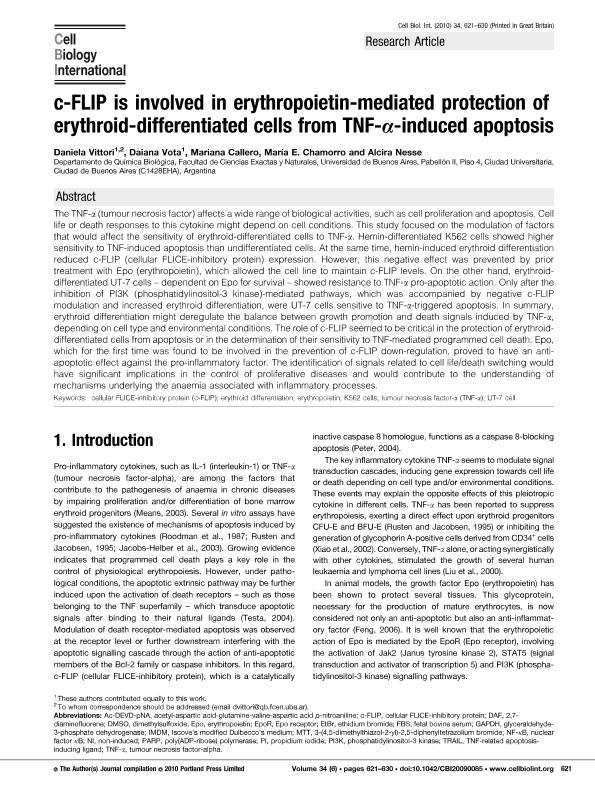Mostrar el registro sencillo del ítem
dc.contributor.author
Vittori, Daniela Cecilia

dc.contributor.author
Vota, Daiana Marina

dc.contributor.author
Callero, Mariana Alejandra

dc.contributor.author
Chamorro, María Eugenia

dc.contributor.author
Nesse, Alcira Beatriz

dc.date.available
2018-12-12T20:22:35Z
dc.date.issued
2010-06
dc.identifier.citation
Vittori, Daniela Cecilia; Vota, Daiana Marina; Callero, Mariana Alejandra; Chamorro, María Eugenia; Nesse, Alcira Beatriz; c-FLIP is involved in erythropoietin-mediated protection of erythroid-differentiated cells from TNF-α-induced apoptosis; Academic Press Ltd - Elsevier Science Ltd; Cell Biology International; 34; 6; 6-2010; 621-630
dc.identifier.issn
1065-6995
dc.identifier.uri
http://hdl.handle.net/11336/66370
dc.description.abstract
The TNF-α (tumour necrosis factor) affects a wide range of biological activities, such as cell proliferation and apoptosis. Cell life or death responses to this cytokine might depend on cell conditions. This study focused on the modulation of factors that would affect the sensitivity of erythroid-differentiated cells to TNF-α. Hemin-differentiated K562 cells showed higher sensitivity to TNF-induced apoptosis than undifferentiated cells. At the same time, hemin-induced erythroid differentiation reduced c-FLIP (cellular FLICE-inhibitory protein) expression. However, this negative effect was prevented by prior treatment with Epo (erythropoietin), which allowed the cell line to maintain c-FLIP levels. On the other hand, erythroiddifferentiated UT-7 cells - dependent on Epo for survival - showed resistance to TNF-α pro-apoptotic action. Only after the inhibition of PI3K (phosphatidylinositol-3 kinase)-mediated pathways, which was accompanied by negative c-FLIP modulation and increased erythroid differentiation, were UT-7 cells sensitive to TNF-α-triggered apoptosis. In summary, erythroid differentiation might deregulate the balance between growth promotion and death signals induced by TNF-α, depending on cell type and environmental conditions. The role of c-FLIP seemed to be critical in the protection of erythroiddifferentiated cells from apoptosis or in the determination of their sensitivity to TNF-mediated programmed cell death. Epo, which for the first time was found to be involved in the prevention of c-FLIP down-regulation, proved to have an antiapoptotic effect against the pro-inflammatory factor. The identification of signals related to cell life/death switching would have significant implications in the control of proliferative diseases and would contribute to the understanding of mechanisms underlying the anaemia associated with inflammatory processes. © The Author(s) Journal compilation © 2010 Portland Press Limited.
dc.format
application/pdf
dc.language.iso
eng
dc.publisher
Academic Press Ltd - Elsevier Science Ltd

dc.rights
info:eu-repo/semantics/openAccess
dc.rights.uri
https://creativecommons.org/licenses/by-nc-sa/2.5/ar/
dc.subject
Cellular Flice-Inhibitory Protein (C-Flip)
dc.subject
Erythroid Differentiation
dc.subject
Erythropoietin
dc.subject
K562 Cells
dc.subject
Tumour Necrosis Factor-Α (Tnf-Α)
dc.subject
Ut-7 Cell
dc.subject.classification
Otras Ciencias Biológicas

dc.subject.classification
Ciencias Biológicas

dc.subject.classification
CIENCIAS NATURALES Y EXACTAS

dc.title
c-FLIP is involved in erythropoietin-mediated protection of erythroid-differentiated cells from TNF-α-induced apoptosis
dc.type
info:eu-repo/semantics/article
dc.type
info:ar-repo/semantics/artículo
dc.type
info:eu-repo/semantics/publishedVersion
dc.date.updated
2018-11-22T15:29:20Z
dc.journal.volume
34
dc.journal.number
6
dc.journal.pagination
621-630
dc.journal.pais
Reino Unido

dc.journal.ciudad
Londres
dc.description.fil
Fil: Vittori, Daniela Cecilia. Consejo Nacional de Investigaciones Científicas y Técnicas; Argentina. Universidad de Buenos Aires. Facultad de Ciencias Exactas y Naturales. Departamento de Química Biológica; Argentina
dc.description.fil
Fil: Vota, Daiana Marina. Consejo Nacional de Investigaciones Científicas y Técnicas; Argentina. Universidad de Buenos Aires. Facultad de Ciencias Exactas y Naturales. Departamento de Química Biológica; Argentina
dc.description.fil
Fil: Callero, Mariana Alejandra. Consejo Nacional de Investigaciones Científicas y Técnicas; Argentina. Universidad de Buenos Aires. Facultad de Ciencias Exactas y Naturales. Departamento de Química Biológica; Argentina
dc.description.fil
Fil: Chamorro, María Eugenia. Consejo Nacional de Investigaciones Científicas y Técnicas; Argentina. Universidad de Buenos Aires. Facultad de Ciencias Exactas y Naturales. Departamento de Química Biológica; Argentina
dc.description.fil
Fil: Nesse, Alcira Beatriz. Consejo Nacional de Investigaciones Científicas y Técnicas; Argentina. Universidad de Buenos Aires. Facultad de Ciencias Exactas y Naturales. Departamento de Química Biológica; Argentina
dc.journal.title
Cell Biology International

dc.relation.alternativeid
info:eu-repo/semantics/altIdentifier/url/https://onlinelibrary.wiley.com/doi/abs/10.1042/CBI20090085
dc.relation.alternativeid
info:eu-repo/semantics/altIdentifier/doi/https://doi.org/10.1042/CBI20090085
Archivos asociados
